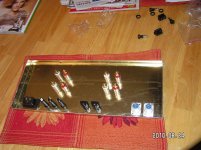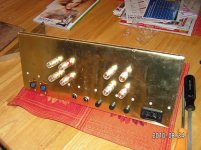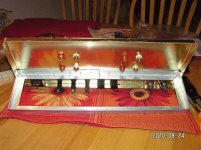Oops... Sorry for the typo, I meant K73-16, similar to the pictured one.
I found no difference between them and WIMA MKP-2, sonically. However, construction is a bit different, since military people had different demands.
Still polyester but as good as some PP then.
Still polyester but as good as some PP then.
Yes.
And here is a rear panel layout.
Attachments
Which kinks do you mean?
Oh, there are so many that you can't miss them. Take the one above R40 for example - it makes no sense to route the trace upwards and then down again, it takes extra room, it might cause problems when etching the PCB and it loojks ugly. You can find more of these all over the board.
That's what an "autorouter" does, the computer program links points together. Then you smooth it out/correct it manually. Hence the "preliminary" description.
A: My autorouter would never create such a mess. I doubt this is autorouter's fault (if it is, it has its rules set incorrectly, there is no explanation for most of those kinks with any sane set of rules).
B: Why use autorouter (with possibly broken rules-set) on such a simple board in the first place ?
B: Why use autorouter (with possibly broken rules-set) on such a simple board in the first place ?
Michael Koster / Wavebourn.
Those distortion curves looked very familiar - a quick wade thru' the pile of papers and I found that graph.
Wireless World December 1978
"Audio power amplifier design - 5" by Peter J Baxandall
In which he shows mathematically:
1) 6dB of global feedback will reduce 2H by about 6dB at the expense of increased higher order distortion
2) 16.5db of global feedback is required to reduce the 3rd harmonic back to the no global feedback level
3) 35dB of global feedback is required to reduce the 6th harmonic back to the no global feedback level
I have a pdf of that article. PM me if you want it and can't find it on the web.
I recall Allen Wright saying that his "guru" told him that global feedback needs to be 40dB or NONE.
Personally I like none.
Cheers,
Ian
After following the philosophy of Kuei Yang Wang and leaving the OPT out of any feedback loop I have to report that I think he was right. I have also taken his view of using feedback around the driver+output tube to give a low impedance drive to the OPT.
With that in mind I now have on my (integrated) amp an input tube (common cathode, no feedback, bypassed cathode resistor) feeding the driver/output stage, which is a 6N2P SRPP driving a GU50 (pentode mode G2 = 255V) with about 37dB of feedback (from GU50 anode to lower SRPP triode's cathode).
This actually sound extremely fine, I've been listening to it for a couple of days now and instruments and voices sound more real that they have before. The next test is to try and wire up a pot so that I can sweep the NFB around that stage at will between 20dB and 37dB to see what the effect is.
So this is not GNFB as I miss out the OPT and the input stage - but there is very heavy feedback in there between the driver and output tubes.
Awesome. Since they have yet to invent a perfect real-life transformer it is obvious that your transformer is making the instruments and vocies "more real" than they were before. Perhaps during recording some sort of opposite process took place and your transformer, now that it is outside the feedback loop, is reversing it.
This might explain why "audiophiles" appreciate single ended no-feedback-whatsoever amplifiers (transformer reverses recording mishaps and SE stage adds further pleasat distortions).
This might explain why "audiophiles" appreciate single ended no-feedback-whatsoever amplifiers (transformer reverses recording mishaps and SE stage adds further pleasat distortions).
Awesome. Since they have yet to invent a perfect real-life transformer it is obvious that your transformer is making the instruments and vocies "more real" than they were before. Perhaps during recording some sort of opposite process took place and your transformer, now that it is outside the feedback loop, is reversing it.
No I think that's quite unlikely. What is a vocie?
You'll have to dig out the original article but there are good reasons why a transformer can sound better outside of a feedback loop, one of which was that the open-loop gain of a circuit including a (band limiting) OPT can be too low for feedback to correct (I.e. near or lower than the amps gain with feedback added), but in front of the transformer the feedback works as advertised with a broadband high open loop gain, presenting the primary with a low impedance low distortion drive. It also of course removes another source of instability in the loop.
Article link
Last edited:
So, after making GU-50 output stages happy using local feedbacks from their anodes to anodes of corresponding driving pentodes 6J51P arranged as a LTP, I add global negative feedback from output of the transformer to the cathode of the 1'st pentode (half of ECF200). Such a nice balance between feedbacks results in smooth amplification of wide dynamic range and wide frequency band, resulting in extremely low phase distortions.
So, both live voice & acoustic recordings and loud orchestras sound very real. Especially, driving my quasi-planar line array columns.
So, both live voice & acoustic recordings and loud orchestras sound very real. Especially, driving my quasi-planar line array columns.
No I think that's quite unlikely. What is a vocie?
A typo ('c' and 'i' transposed, the word should have spelled "voices").
[qoute]but in front of the transformer the feedback works as advertised with a broadband high open loop gain[/quote]
It sure does, at the cost of leaving all the OPT distortions in. As you pointed out this might actually be beneficial (if it reverses distortions caused by the recording process which make recordings sound unnatural, less "real", as you put it).
I've seen arguments stating that it is not the tube distortion that people like, rather it is the OPT distortion (think about it, there is a female designer out there known for her solid-state OPT-coupled designs so there must be something to it ? 😕 ). It could be that you're witnessing the same thing. Once you eliminate tubey distortion by the way of feedback, it could just as well have been an opamp feeding your OPT so perhaps it's not the tubes that do the goody stuff to our music.
Member
Joined 2009
Paid Member
The next test is to try and wire up a pot so that I can sweep the NFB around that stage at will between 20dB and 37dB to see what the effect is.
This will be interesting. I'm not expecting you to notice much difference, if any, between these two extremes. If you could sweep it down to 0dB of feedback then I'd expect you to find it a lot more noticeable. I've never tried this myself but I remember reading a magazine review (or was it 6 moons?) where they had a commercial tube amp that had a variable nfb control that went from 0dB upwards. They found that 0dB was by the far the best position for that control and that a little nfb was bad - but I've no memory of where the fb loop was implemented.
They found that 0dB was by the far the best position for that control and that a little nfb was bad - but I've no memory of where the fb loop was implemented.
If zero db was far the best position already, it should be a very good amp that would not suffer from a feedback until compensation become necessary that caused audible effects.
I don't understand that.
May be it was something about their speakers that sounded far the best when driven by relatively high impedance?
This will be interesting. I'm not expecting you to notice much difference, if any, between these two extremes. If you could sweep it down to 0dB of feedback then I'd expect you to find it a lot more noticeable. I've never tried this myself but I remember reading a magazine review (or was it 6 moons?) where they had a commercial tube amp that had a variable nfb control that went from 0dB upwards. They found that 0dB was by the far the best position for that control and that a little nfb was bad - but I've no memory of where the fb loop was implemented.
This is in a Martin Colloms article I referred to earlier in the thread. Sweeping to 0dB is non trivial for me as a) the topology lends itself to serial resistive changes only;- as the bottom leg of the divider is an SRPP cathode resistor, and b) removing the feedback brings massive gain (and with it hum and noise).
Also this is not technically GNFB - it's making a pentode connected GU-50 have a very low output impedance to drive the OPT - rather than being there for linearity. Plus you get the full 'tubey' from the input triode - which I like to refer to as my integrated pre-amplifier 😉
May be it was something about their speakers that sounded far the best when driven by relatively high impedance?
I think the speakers + amp for a symbiotic system, there are just too many variables (impedance plots, sensitivity, brightness/balance, diffraction effects) that all interact or overlap with amplifier characteristics.
In general most speakers seem to be designed for solid state - so finding a speaker where they have spent the extra on a zobel for instance is rare and unknown. I do most of my testing into a pair of old Cantor IIIs which are pretty easy to drive - and then switch to my main system Usher X-718 which also seem to have an easy drive.
A little feedback can be a bad thing. You either need none, or enough. If you wanted to be perverse you could find an intermediate feedback level which maximised a particular higher-order distortion - and so 'tune' the amp for worst sound!
Member
Joined 2009
Paid Member
and so 'tune' the amp for worst sound!
Will all the crazy things going on in the DIY audio community, the debates, crazy ideas and all the rest, I never saw anyone try to make the worse sound - I like it, this is really thinking outside the box 😀
I propose an amplifier with multiple cascaded BJT gain stages and 5dB of gnf, excessive gain is 'thrown away' with resitive dividers; stages are capacitively coupled. The delux version is designed to clip asymmetrically at low signal levels.
Last edited:
Will all the crazy things going on in the DIY audio community, the debates, crazy ideas and all the rest, I never saw anyone try to make the worse sound - I like it, this is really thinking outside the box 😀
erhaps not in these same words but there are a couple of quite recent threads that describe some sort of sound mangling device - Wavebourn posted on not long ago, the circuit adds extra harmonics to the sound ("more tube sound"), I suppose one could say it makes the sound worse if one is into pure reproduction.
I propose an amplifier with multiple cascaded BJT gain stages and 5dB of gnf, excessive gain is 'thrown away' with resitive dividers; stages are capacitively coupled. The delux version is designed to clip asymmetrically at low signal levels.
I've often wondered how no-NFB transistor amplifier (using the most linear devices avaliable) would sound but I'm too lazy to put one together and try it out for myself 😀
Isn't that what part of the argument is about? Are we all into pure reproduction, or do some or all of us prefer some degree of processing? Nothing wrong with processing if that is what people want - just don't pretend that it is reproduction.I suppose one could say it makes the sound worse if one is into pure reproduction
Think of it like ice cream. People have different preferences, many like vanilla, other prefer strawberry etc. There are some people trying to make pure unflavoured ice cream, while others make fine quality vanilla. Then some people come along and buy the vanilla, because that is what they prefer, but they claim that the vanilla ice cream is purer than the unflavoured stuff because the unflavoured ice cream has impurities in it. Now of course some of the unflavoured stuff does contain impurities, and some does taste nasty, but some of it is quite good. The vanilla contains some impurities too, and it definitely contains vanilla! You can test it in a lab. So they say that the vanilla is still purer and unflavoured, despite the proven presence of vanilla and the known preference of most people for a little vanilla flavour. They say that their taste buds can detect impurities in the unflavoured ice cream which the lab cannot find because it is doing the wrong tests.
Some of them buy unflavoured ice cream and add a little vanilla to it, then say that this has improved the flavour by removing the impurities. To everyone else it is obvious that they have simply added their favourite flavour, but they cannot admit this because for some reason they feel there is a stigma attached to preferring vanilla. So they continue to claim that vanilla ice cream, whether originally made that way or after their own addition, is purer than unflavoured ice cream.
This is modern audio! OK, maybe I am exaggerating a little but while some people add vanilla (e.g. tube buffers) to unflavoured ice cream (e.g. good SS) and claim that the result has lost its impurities then my point stands. I will now duck and wait for the flack!
- Status
- Not open for further replies.
- Home
- Amplifiers
- Tubes / Valves
- global negative feedback schematic


